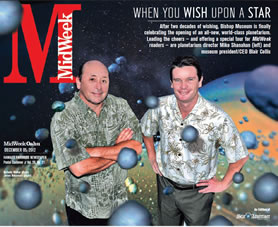When You Wish Upon A Star
“(Bishop Museum) is a long-lived institution. It’s easy to become entrenched,” he admits. “We are in the process of reinventing the leading Hawaiian cultural museum in the world to reveal the depth of this institution. The state-of-the-art Planetarium is an embodiment of that.”
Partnerships have allowed exciting programming. A grant from the Castle Foundation allowed the museum to create new planetarium programming for young children, which will debut this month. A new program on Polynesian navigation also is in the works. The program is being created as part of a U.S. Department of Education-funded partnership with Polynesian Voyaging Society led by Hawaiian navigator Nainoa Thompson and University of Hawaii’s College of Education.
A grant from the National Aeronautics and Space Administration (NASA) will fund a portable digital planetarium, allowing educational outreach to the Neighbor Islands. Curricula development, programming and a new exhibit on NASA earth sciences are part of the project.
“This is the most important year for our planetarium in a very long time,” says Shanahan.
Originally called the Kilohani Planetarium, the Watumull Planetarium – named for local retail store pioneer Jhamandas Watumull – has served more than 6 million visitors and students since it opened in 1961.
Honolulu’s planetarium is one of more than 3,000 worldwide but one of only six in the nation with the digital hybrid system. Its sophisticated Digistar system and software contains the most comprehensive set of astronomical data ever assembled, including proprietary input from the American Museum of Natural History and NASA.
With growing interest in extraterrestrial phenomena, including space travel and moon explorations, Hawaii and Bishop Museum are well-positioned to play key roles. Who would have guessed when the ancient Polynesians followed the stars to discover these islands that their venture-some spirit would manifest itself in progressive opportunities centuries later?
It’s poetic that Bishop Museum’s “new” planetarium is being unveiled in mid-December, the start of the traditional makahiki season. Ancients celebrated this time to harvest and renew the gifts of the earth, as well as rededicate themselves spiritually to peace and harmony.
Astronomical highlights for 2013, according to Shanahan, include a partial eclipse of the sun May 9 when one-third of the sun will be covered by the moon. The annual Perseid meteor shower peaks Aug. 11-12, when viewing will be good for meteor hunting from midnight till dawn.
Shanahan says next summer will be an excellent time for viewing Saturn and its rings. The planet will be tipped nicely for Earthlings to view the sixth planet from the sun.
But if you miss all of those events, you can simulate the experience by sitting in a comfortable seat in the Bishop Museum planetarium and watch the night sky on its 30-foot dome theatre.
Now that’s the kind of dancing with the stars we can all champion.
Bishop Museum, 1525 Bernice St., is open 9 a.m. to 5 p.m. daily except Tuesdays and Dec. 25. Phone 847-3511. website: bishopmuseum.org.






